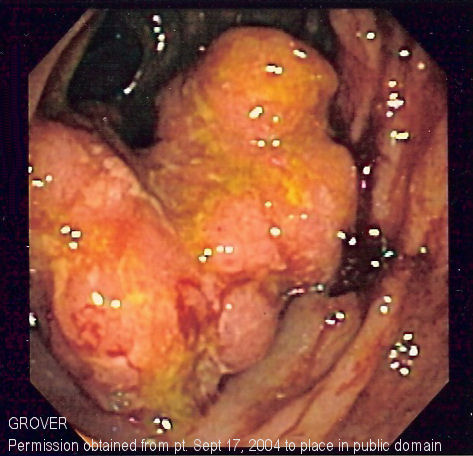Colorectal cancer screening
|
Colorectal cancer Microchapters |
|
Diagnosis |
|---|
|
Treatment |
|
Case Studies |
|
Colorectal cancer screening On the Web |
|
American Roentgen Ray Society Images of Colorectal cancer screening |
|
Risk calculators and risk factors for Colorectal cancer screening |
Editor(s)-in-Chief: C. Michael Gibson, M.S., M.D. [1] Phone:617-632-7753; Elliot B. Tapper, M.D., Beth Israel Deaconess Medical Center; Michael Maddaleni, B.S.
Overview
In recent memory, there have been improvements made in the screening process for colon cancer. Knowing a few of the most important facts can greatly help in reducing the risk of developing colon cancer.
- Research has shown that a colonoscopy detects colon cancer in 98-99% of the cases.[1]
- Current guidelines suggest that a colonoscopy is the best screening tool for colon cancer.
- A colonoscopy every 10 years reduces the risk of left sided colon cancer but not as much for right sided colon cancer.
- Right sided colon cancers are more likely to be missed.
- Right sided is harder to reach
- Right sided could be flat, which means they would be harder to detect.
- Right sided colon cancers are more likely to be missed.
- Flat growths (non-polypoid)[1]
- More difficult to detect.
- More likely to progress to colon cancer than cylindrical polyps.
- Spray on dyes may better help to detect them.
Screening procedures
Colorectal cancer can take many years to develop and early detection of colorectal cancer greatly improves the chances of a cure.
The U.S. Preventive Services Task Force (USPSTF) recommends screening all patients aged 50-75 for colorectal cancer.[2]
The American College of Gastroenterology[3] recommends:
- Screening is recommended in African Americans beginning at age 45 years.
- CT colonography every 5 years is the radiographic screening alternative, when patients decline colonoscopy.
- Fecal immunochemical test for blood (FIT) is preferred over guaiac-based fecal occult blood testing.
The modalities recommended are below.
Fecal occult blood testing
Fecal occult blood test (FOBT): a test for blood in the stool. Two types of tests can be used for detecting occult blood in stools i.e. guaiac based (chemical test) and immunochemical. The sensitivity of immunochemical testing is superior to that of chemical testing without an unacceptable reduction in specifity. [4]
Endocopy
- Sigmoidoscopy: A lighted probe (sigmoidoscope) is inserted into the rectum and lower colon to check for polyps and other abnormalities.
- Colonoscopy: A lighted probe called a colonoscope is inserted into the rectum and the entire colon to look for polyps and other abnormalities that may be caused by cancer. A colonoscopy has the advantage that if polyps are found during the procedure they can be immediately removed. Tissue can also be taken for biopsy.

Other screening techniques
- Double contrast barium enema (DCBE): First, an overnight preparation is taken to cleanse the colon. An enema containing barium sulfate is administered, then air is insufflated into the colon, distending it. The result is a thin layer of barium over the inner lining of the colon which is visible on X-ray films. A cancer or a precancerous polyp can be detected this way. This technique can miss the (less common) flat polyp.
- Virtual colonoscopy replaces X-ray films in the double contrast barium enema (above) with a special computed tomography scan and requires special workstation software in order for the radiologist to interpret. This technique is approaching colonoscopy in sensitivity for polyps. However, any polyps found must still be removed by standard colonoscopy.
- Blood tests: Measurement of the patient's blood for elevated levels of certain proteins can give an indication of tumor load. In particular, high levels of carcinoembryonic antigen (CEA) in the blood can indicate metastasis of adenocarcinoma. These tests are frequently false positive or false negative, and are not recommended for screening, it can be useful to assess disease recurrence.
- Stool DNA testing detects DNA shed into the stool from the cells of pre-malignant adenomas and cancers. The DNA is not degraded during the digestive process and remain stable in the stool. Capture, followed by Polymerase Chain Reaction amplifies the DNA to detectable levels for assay. Clinical studies have shown a cancer detection sensitivity of 71%-91%[5], and may be more sensitive than fecal immunochemical testing.[6]
Genetic counseling
- Genetic counseling and genetic testing for families who may have a hereditary form of colon cancer, such as hereditary nonpolyposis colorectal cancer (HNPCC) or familial adenomatous polyposis (FAP).
References
- ↑ 1.0 1.1 American Society of Clinical Oncology. 2010. Progress in Cancer Screening. http://owl.english.purdue.edu/owl/resource/560/10/
- ↑ Screening for Colorectal Cancer: U.S. Preventive Services Task Force Recommendation Statement.Ann Intern Med. 2008;149:627-637.
- ↑ Rex DK, Johnson DA, Anderson JC, et al. American College of Gastroenterology guidelines for colorectal cancer screening 2009.Am J Gastroenterol. 2009 Mar;104(3):739-50.
- ↑ Weitzel JN: Genetic cancer risk assessment. Putting it all together. Cancer 86:2483,1999. PMID 10630174
- ↑ B. Greenwald (2006). "The DNA Stool Test - An Emerging Technology in Colorectal Cancer Screening".
- ↑ Imperiale TF, Ransohoff DF, Itzkowitz SH, Levin TR, Lavin P, Lidgard GP; et al. (2014). "Multitarget stool DNA testing for colorectal-cancer screening". N Engl J Med. 370 (14): 1287–97. doi:10.1056/NEJMoa1311194. PMID 24645800.